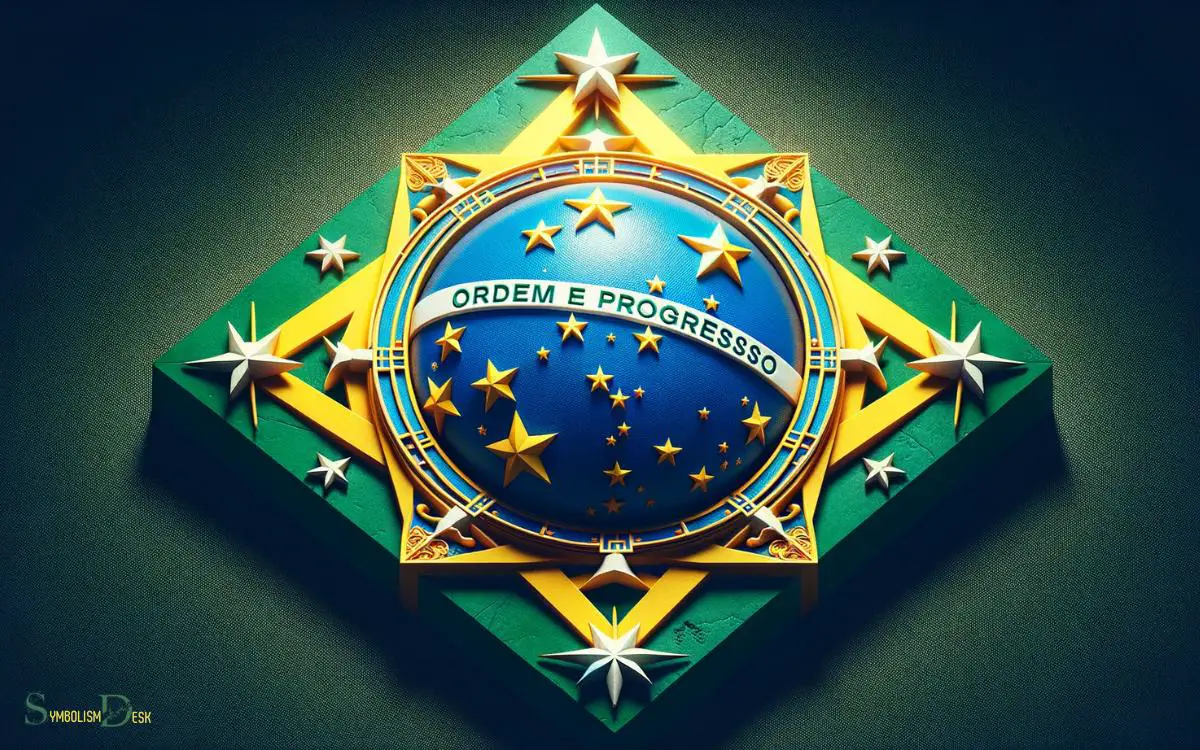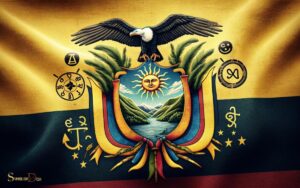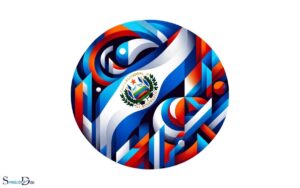What Do the Symbols on the Brazilian Flag Mean? A Guide
The Brazilian flag features a blue globe with 27 small stars, representing the country’s 26 states and the Federal District.
The national motto “Ordem e Progresso” (“Order and Progress”) appears within the globe. Green represents Brazil’s lush fields and forests, while yellow symbolizes the country’s gold reserves.
The Brazilian flag is rich in symbolism, and its colors and elements represent significant facets of the country’s history, geography, and natural resources.
The green field symbolizes the House of Braganza of Pedro I, the first Emperor of Brazil, and the yellow diamond signifies the House of Habsburg that Empress Maria Leopoldina belonged to.
The blue globe at the center contains 27 small stars, patterned after the night sky as it was on November 15, 1889. Each star corresponds to a Brazilian state, with the largest representing the Federal District.

Key Takeaway
6 Symbols and Meanings of the Brazilian Flag
| Symbol | Meaning |
|---|---|
| Green Rectangle | Represents the Brazilian fields and forests. Initially, represented the House of Braganza of Pedro I, the first Emperor of Brazil. |
| Yellow Diamond | Represents the country’s wealth in gold and its richness. Initially, represented the House of Habsburg that Empress Maria Leopoldina came from. |
| Blue Circle | Represents the sky above Rio de Janeiro on the morning of November 15, 1889, which is the day Brazil became a republic. |
| Stars | Each of the 27 stars represents one of Brazil’s 26 states and the Federal District. |
| National Motto | “Ordem e Progresso” (Order and Progress) is inspired by Auguste Comte’s motto of positivism: “Love as principle, order as the basis, progress as the goal.”. |
| Brazilian Coat of Arms (within the diamond) | Represents the country’s coffee and rubber industries as these were the primary crops at the time the coat of arms was designed. |
Evolution of the Brazilian Flag
As the history of the Brazilian flag evolved, several significant changes were made to its design and symbolism.
The original flag, adopted in 1822, featured a green background with a yellow diamond in the center, representing the House of Braganza.
Over time, the flag underwent various modifications.
The most notable change occurred in 1889 when Brazil became a republic, leading to the addition of a blue globe with stars that represented the Brazilian states and the national motto ‘Order and Progress.’
The stars also depict the constellation of the Southern Cross, a prominent feature in the Brazilian night sky.
These alterations reflect the country’s shifting political and cultural landscape, as well as its aspiration for unity and progress.
Today, the Brazilian flag stands as a powerful symbol of national identity and heritage.
Understanding the Color Scheme
The color scheme of the Brazilian flag, comprising green, yellow, blue, and white, reflects the nation’s historical and cultural evolution.
The green symbolizes the lush Amazon rainforest and represents the House of Braganza, the Brazilian imperial family.
Yellow represents the wealth of the country, particularly its vast resources and the Brazilian gold rush.
Blue is a tribute to the House of Habsburg, the royal family of Brazil, and signifies the sky over Rio de Janeiro on the day the country declared independence from Portugal.
The white stars on the blue circle depict the night sky above Rio de Janeiro on November 15, 1889, the day the Brazilian Republic was proclaimed.
Each color holds deep historical significance, embodying Brazil’s journey from colonialism to independence and the rich natural and cultural heritage of the nation.
Insight Into the National Motto
Reflecting the values and aspirations of the Brazilian nation, the national motto, ‘Ordem e Progresso’ (Order and Progress), serves as a guiding principle for the country’s development and unity.
The motto encapsulates the collective desire for societal harmony and advancement, embodying the following ideals:
- Unity in diversity: Embracing the rich tapestry of cultures and traditions within Brazil to foster national cohesion.
- Economic advancement: Striving for prosperity and innovation to improve the lives of all citizens.
- Social harmony: Promoting equality, justice, and solidarity among all members of society.
- Technological progress: Embracing advancements in science and technology to drive national development.
- Political stability: Upholding democratic principles and governance to ensure a stable and harmonious society.
The national motto, therefore, serves as a powerful symbol of Brazil’s commitment to progress, unity, and inclusivity.
Symbolism of the Southern Cross
The Southern Cross constellation holds significant symbolism on the Brazilian flag, representing the country’s historical and cultural ties to the Southern Hemisphere.
This celestial symbol is deeply intertwined with Brazil’s history and has influenced the nation’s identity, serving as a marker of its geographical location and connection to the wider world.
Understanding the Southern Cross’s representation provides valuable insight into the multifaceted symbolism embedded within the Brazilian flag. Understanding the Southern Cross’s representation provides valuable insight into the multifaceted symbolism embedded within the Brazilian flag. This celestial feature not only reflects Brazil’s geographical location in the Southern Hemisphere but also conveys a deeper connection to the country’s national identity and aspirations. Similarly, exploring the el salvador flag symbol meaning highlights the importance of celestial and ideological elements, as the blue and white stripes and national emblem in El Salvador’s flag emphasize unity, peace, and historical heritage.
Southern Cross Constellation Significance
Significantly, the Southern Cross constellation on the Brazilian flag represents the country’s astronomical heritage and its connection to the southern hemisphere.
The Southern Cross holds deep significance for Brazilians, evoking a sense of pride and cultural identity due to its historical and navigational importance.
The constellation symbolizes exploration, as it guided sailors and explorers across the southern seas during the Age of Discovery. It also represents a connection to nature and the environment, reminding Brazilians of their country’s rich biodiversity and natural beauty.
Lastly, it inspires a sense of wonder and curiosity, encouraging people to look up at the night sky and contemplate the mysteries of the universe.
Representation of Brazil’s History
The placement of the Southern Cross constellation on the Brazilian flag highlights the historical and navigational significance it holds for the country.
The Southern Cross has been a guiding light for sailors and explorers, playing a pivotal role in Brazil’s maritime history.
Its inclusion on the flag symbolizes the country’s rich seafaring heritage, linking it to the voyages of discovery and the exploration of new lands.
The constellation’s presence serves as a tribute to the explorers who charted new territories and played a fundamental role in shaping Brazil’s history.
Its representation on the flag underscores the deep-rooted connection between Brazil and its maritime past, emphasizing the country’s historical ties to exploration and discovery. This historical significance of the Southern Cross has greatly influenced Brazil’s national identity.
Influence on National Identity
Symbolizing Brazil’s historical ties to exploration and discovery, the presence of the Southern Cross on the flag has significantly influenced the country’s national identity.
The symbolism of the Southern Cross evokes a strong emotional response in the Brazilian people, representing:
- A connection to the country’s rich history of exploration and maritime accomplishments.
- A sense of national pride and unity, as the Southern Cross is a distinct feature of the Brazilian night sky.
- The enduring spirit of adventure and curiosity that has driven Brazil’s progress and development.
- A reminder of the country’s diverse cultural heritage and the contributions of indigenous peoples to its identity.
- The promise of a bright and hopeful future, inspired by the guiding light of the Southern Cross.
Representation of the 27 Stars
Representing the 27 federative units of Brazil, the stars on the flag are arranged in the same pattern as the night sky over Rio de Janeiro on November 15, 1889. The stars’ positioning on the flag reflects the actual sky on the night when the Brazilian Republic was declared.
Each star represents a specific state, with the larger star in the center symbolizing the state of Goiás.
The stars are depicted in the same pattern as they appeared in the sky on the historic night, creating a visual representation of the unity and alignment of the Brazilian states at the time of the country’s proclamation as a republic.
This celestial arrangement conveys a powerful message of unity and harmony among the Brazilian states.
This celestial arrangement seamlessly transitions into the subsequent section about the interpretation of the coat of arms.
Interpretation of the Coat of Arms
Continuing from the previous subtopic, the 27 stars on the Brazilian flag seamlessly lead to the interpretation of the coat of arms, a pivotal emblem of national significance.
- The Southern Cross constellation symbolizes Brazil’s sky and its 26 states.
- The blue circle represents the sky over Rio de Janeiro on November 15, 1889, when the Brazilian Republic was declared.
- The coffee branch and the tobacco branch symbolize the country’s main agricultural products.
- The motto ‘Ordem e Progresso’ (Order and Progress) reflects the country’s aspirations.
- The green and yellow colors represent the House of Braganza, the Brazilian Imperial Family.
The interpretation of the coat of arms encapsulates Brazil’s rich history, aspirations, and natural beauty, serving as a powerful representation of the nation’s identity.
Do Symbols on the Portuguese and Brazilian Flags Have Any Similar Meanings?
The symbol meaning portuguese flag differs from its Brazilian counterpart. The Portuguese flag has a coat of arms containing five blue shields and five white shields, representing victories over five Moorish kings, while the Brazilian flag has a green field with a yellow diamond, symbolizing the House of Braganza, the Brazilian royal family.
Cultural Significance of the Flag
The cultural significance of the Brazilian flag is underscored by its representation of the nation’s history, values, and unity. The flag’s green background symbolizes the lushness of Brazil’s forests, while the yellow diamond represents the country’s wealth in gold.
The blue globe inside the diamond depicts the celestial hemisphere over Rio de Janeiro on November 15, 1889, the day the Brazilian republic was declared.
The 27 stars scattered across the globe represent the Brazilian states and the Federal District. This symbolism reflects the country’s rich natural resources, its diverse states, and the unity of its people under a single democratic government.
| Symbol | Representation |
|---|---|
| Green | Lushness of Brazil’s forests |
| Yellow | Brazil’s wealth in gold |
| Blue Globe | Celestial hemisphere on Nov 15, 1889 |
| 27 Stars | Represent the Brazilian states |
Conclusion
In conclusion, the symbols on the Brazilian flag hold deep historical and cultural significance, akin to the intricate threads of a tapestry. The green background represents the lush forests of Brazil, while the yellow rhombus symbolizes the country’s wealth in gold. The blue circle with the stars represents the night sky over Rio de Janeiro on November 15, 1889, the day the Brazilian Republic was declared. Just as the symbols on the Brazilian flag hold deep meaning, the symbols on the Portuguese flag also carry significant historical and cultural importance. The Portuguese flag symbol meaning is deeply rooted in the country’s history, representing aspects such as exploration, discovery, and colonial influence.
From the evolution of the flag to the representation of the Southern Cross and the 27 stars, each element has been carefully chosen to reflect the nation’s values and aspirations.
The flag serves as a powerful emblem of Brazil’s rich heritage and unity.






